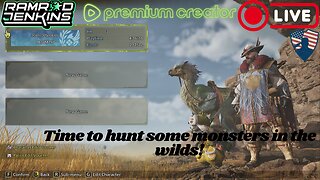Premium Only Content

Paganism in History
https://solitarypaganism.com/paganism-explained/paganism-in-history/
The customs and spiritual practices of the early, pre-Christian Pagan cultures were passed down from one generation to the next.
These old ways were traditions for respecting and interacting with the gods and other spirit denizens, and they varied from one culture to another.
The Anglo-Saxons, for example, gave due offerings before a wéoh, which was an image or symbol of the honored deity.
The early Roman honored his family’s numina (guardian spirits) at a household lararium, an object often resembling a small cupboard, which served as a home for those spirits.
The early Greeks began every ritual with an offering to the goddess Hestia.
Each culture had its own customs.
Many Paleo-Pagans— whether Greek or Roman or Saxon—were undoubtedly passionate and sincere in their piety, but their spiritual paths were largely a matter of circumstance rather than choice.
The Celt and the Egyptian, the Saxon, and the Greek, they observed their respective customs because those were the only customs they were familiar and comfortable with.
By contrast, contemporary Pagans—almost without exception—intentionally choose the paths we follow.
This is necessarily true for the “first-generation Pagan” who was not raised as a Pagan, but in today’s multicultural environment even children born into polytheist households are usually encouraged to explore and appreciate other spiritual paths and to choose their own paths with knowledge and intention.
Today’s Pagan—whether or not raised in a Pagan home—makes a conscious decision about his or her personal spiritual journey.
This intentional choice may be one of the most significant distinctions between contemporary Pagans and our Paleo-Pagan ancestors.
We have expectations of our spiritual paths.
For the majority of today’s Pagans, this includes the expectation of a connection between us and the earth, so much so that Pagan spirituality has often been labeled “earth religion”, or “earth-based religion”.
Our ancestors had no need to reconnect with the earth; they were immersed in its whims and tides.
In the pre-industrial world, the rural population was much greater than it is today.
Urban centers like Rome and Athens were few and far between, and even in those ancient cities the residents were far more directly affected by the earth’s mood swings.
Today, in developed nations at least, we need not fear starvation if the local grain crop fails.
For the majority of us, severe winter weather only means a higher-than-usual utility bill.
We are still dependent on the earth, but not as directly as our ancestors were, and for the most part, this is a good thing.
Nevertheless, we have lost something in the process, and it is this disconnection from the natural world that has inspired many people to explore “earth-based” Pagan spirituality.
Because of this intentional spirituality, Pagans today often attempt to follow what the early Saxons might have called Hal Sidu, meaning healthy or holistic traditions.
Hal Sidu engages and integrates all parts of the Self.
Exactly how many parts there are depend on one’s spiritual paradigm.
As a Saxon Pagan, I expect Hal Sidu to engage my rational thought, stimulate my memories and emotion, arouse my source of inspiration, balance my physical body and fortify my identity.
In the Saxon tradition, these are all equally important parts of the “Self ”.
Pagans who follow other paths will have other definitions of the Self, of course.
For the sake of simplicity let us make use of a popular contemporary paradigm and define Hal Sidu as the integration of Body, Mind and Spirit.
I use the Old English term Hal Sidu for intentional Pagan spirituality because I follow a Saxon path, but a Roman Pagan might call it the Vetera Valens (“worthy traditions”).
An Ice-landic Pagan could call it Heildræn Venjur (“holistic habits”).
The name is not important.
By any name, intentional Pagan spirituality helps us reconnect with the earth and integrate all parts of the Self into one whole being.
Hal Sidu—or whatever term you prefer—is not a matter of belief.
In fact “belief ” is relatively unimportant in polytheist religions.
Yes, the Paleo-Pagans believed in their gods, but it was in the way modern people believe in gravity or electricity, not in the way a child believes in the Tooth Fairy.
When we apply the logic that we apply to every other aspect of the human experience to our perceptions the divine, it is patently obvious that the gods are real.
We can conclude that the goddess Athena is real, for example, because she has spoken to and interacted with thousands of people over thousands of years —and she is no “less real” just because Bob decides, for whatever reason, to not believe in her existence.
Early Pagans knew the gods are real; for them, it was not an issue of personal belief.
What matters to the polytheist are not people’s beliefs, but people’s actions; their words, and deeds.
Traditional Pagan spirituality is orthopraxic, focusing on shared practices and traditions rather than beliefs.
This remains true even today in Pagan paths such as British Traditional Witchcraft, in most forms of polytheistic Reconstructionism and for the international Neo-Pagan fellowship Ár nDraíocht Féin.
It is your actions that define you and shape the world around you.
And as with all other things, it is by your actions that you integrate Body, Mind and Spirit.
Not by thinking about it.
Not by talking about it.
It is something you do.
When we take no action towards developing an intentional Pagan spirituality, it is often because we do not know where to begin rather than from a lack of desire.
Few books address this issue; how to live as a Pagan after closing the ritual and washing up the chalice or mead horn.
Many Pagans, especially those new to polytheism, are unsure how to reach out and touch the earth both physically and spiritually.
Hal Sidu—holistic custom—demands that we do this very thing; that we touch the earth, taking action to build a personal Pagan lifestyle for each of us.
How you accomplish this will be a reflection of your own interests, needs, and circumstances.
The important thing is not what you do, which will vary from one person to another, but that you do something, some little thing each day to connect with your gods and with the world around you There are many ways to do this.
You might find a connection through rituals that sacralize your daily activities, or by mindfully working with a familiar.
You might find it by literally touching the earth, armed with a spade and a hoe, raising some of your own food, and actively participating in the eternal cycle of receiving and giving back.
Or maybe you will find more inspiration in crafting your own ritual candles and incense.
Whatever the means, building an intentional, personal Pagan lifestyle will help you integrate Body, Mind, and Spirit into something whole and complete.
-
 9:21
9:21
asolitarypagan.com
1 year agoMaking Herbal Salves
1.8K -
 31:39
31:39
Misha Petrov
54 minutes agoThe War on Women’s Spaces
1 -
 LIVE
LIVE
BLoobsGaming
3 hours agoMonster Hunter Wilds! Grinding away Solo
2,136 watching -
 LIVE
LIVE
Meisters of Madness
3 hours agoImpossible and Overpowered - Part 2 (Catch Up)
202 watching -
 LIVE
LIVE
MDGgamin
1 hour ago🔴LIVE - TARKOV - Christ Is King Happy Sunday!!! - #RumbleTakeover
325 watching -
 LIVE
LIVE
RamrodJenkins
3 hours agoTime to HUNT MONSTERS in the WILD! Happy Sunday!
116 watching -
 LIVE
LIVE
Chi-Town Gamers Livestreams
11 hours agoBaldur's Gate 3 W/ CTG & XayRico Ep. 3 | Then GTA Online Later
112 watching -
 LIVE
LIVE
Astral Doge Plays!
7 hours agoFinal Fantasy VI ~LIVE!~ The Floating Continent
2,377 watching -
 LIVE
LIVE
Major League Fishing
3 days agoLIVE Tackle Warehouse Invitationals, Stop 2, Day 3
1,128 watching -
 18:41
18:41
Bearing
1 day agoAMERICA: The Greatest Reality TV Show of ALL TIME!! 🤣🎥
25.7K66